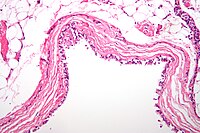
Photo from wikipedia
Objective Dermoid cysts are uncommon in spinal cord tumors, and the phenomenon of their spontaneous rupture into the syrinx cavity is quite rare. We aimed to analyze the imaging characteristics… Click to show full abstract
Objective Dermoid cysts are uncommon in spinal cord tumors, and the phenomenon of their spontaneous rupture into the syrinx cavity is quite rare. We aimed to analyze the imaging characteristics and etiologies, and propose some surgical strategies, for this uncommon phenomenon. Methods We retrospectively reviewed 14 cases with spinal dermoid cysts that ruptured into the cervical and thoracic syrinx cavity. There were six male and eight female cases, aged 21 to 46 years, who had lipid droplets in the syrinx cavity from C1 to L3. The dermoid cysts were always located at the conus. Based on patients’ complaints, clinical manifestations, and imaging results, we adopted tumor excision and/or syrinx cavity aspiration in one stage or multiple stages. Results Three patients had only a syrinx cavity aspiration surgery due to a history of dermoid cyst excision. Eight patients had dermoid cyst resection and syrinx cavity aspiration in one stage. One patient was operated upon in two stages due to the development of new symptoms at nine months follow-up. Two patients underwent only tumor resection since they did not show similar symptoms or signs caused by the cervicothoracic syrinx. The axial magnetic resonance imaging indicated that the lipid droplets were always not at the center but were eccentric. The clinical effect was satisfactory during the follow-up period in this group. Conclusion The lipid droplets filled the spinal syrinx cavity, not entirely confined to the central canal. Based on the chief complaints and associated signs, we adopted different surgical strategies and had satisfactory clinical results.
Journal Title: Journal of Korean Neurosurgical Society
Year Published: 2022
Link to full text (if available)
Share on Social Media: Sign Up to like & get
recommendations!